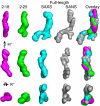Shape of tropoelastin, the highly extensible protein that controls human tissue elasticity
- PMID: 21368178
- PMCID: PMC3060269
- DOI: 10.1073/pnas.1014280108
Shape of tropoelastin, the highly extensible protein that controls human tissue elasticity
Abstract
Elastin enables the reversible deformation of elastic tissues and can withstand decades of repetitive forces. Tropoelastin is the soluble precursor to elastin, the main elastic protein found in mammals. Little is known of the shape and mechanism of assembly of tropoelastin as its unique composition and propensity to self-associate has hampered structural studies. In this study, we solve the nanostructure of full-length and corresponding overlapping fragments of tropoelastin using small angle X-ray and neutron scattering, allowing us to identify discrete regions of the molecule. Tropoelastin is an asymmetric coil, with a protruding foot that encompasses the C-terminal cell interaction motif. We show that individual tropoelastin molecules are highly extensible yet elastic without hysteresis to perform as highly efficient molecular nanosprings. Our findings shed light on how biology uses this single protein to build durable elastic structures that allow for cell attachment to an appended foot. We present a unique model for head-to-tail assembly which allows for the propagation of the molecule's asymmetric coil through a stacked spring design.
Conflict of interest statement
The authors declare no conflict of interest.
Figures






References
-
- Li DY, et al. Elastin is an essential determinant of arterial morphogenesis. Nature. 1998;393:276–280. - PubMed
-
- Niklason LE, et al. Functional arteries grown in vitro. Science. 1999;284:489–493. - PubMed
-
- Niklason LE, Langer R. Prospects for organ and tissue replacement. Jama J Am Med Assoc. 2001;285:573–576. - PubMed
-
- Vrhovski B, Weiss AS. Biochemistry of tropoelastin. Eur J Biochem. 1998;258:1–18. - PubMed
Publication types
MeSH terms
Substances
Grants and funding
LinkOut - more resources
Full Text Sources
Other Literature Sources

